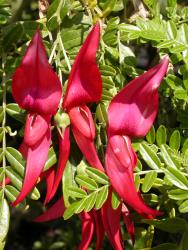- Taxon
- Gallery
- ≡ Clianthus puniceus var. maximus (Colenso) Kirk, Stud. Fl. New Zealand 118 (1899)
Upright or spreading multistemmed shrub, 1-4 m high, 1-6 m wide, branching from near base; branches often layering and giving rise to new genets. Cotyledons 2(-3), 15-20 × 7-10 mm, broadly oblong to broadly elliptic, ± patent, light green; lamina each side of midrib sometimes asymmetrical, sometimes ± weakly lunate; apex rounded; base oblique. Leaves 100-150 × 40- 85 mm, imparipinnate, 19-23-foliolate, lower 1-2 leaflet pairs ± opposite, otherwise alternate; petiole and rachis up to 125 mm long, up to 2.2 mm diam., channelled. Leaflet lamina 20-44 × 7-14mm, lanceolate, oblong, oblong-lanceolate to elliptic; leaflets at distal end sometimes smaller, although terminal leaflet usually similar in size to lower proximal leaflets; adaxial surface green to dark green, glossy, glabrous to sparsely to moderately hairy; abaxial surface pale green, matt, sparsely to moderately hairy; margins slightly recurved; apex retuse; base obtuse, sometimes slightly cordate; petiolule 0.4-0.9 mm long, light green, sparsely to densely hairy; stipules 7-8 × 2.6-4 mm, lanceolate to narrowly triangular, green, adaxial surface glossy, abaxial surface matt, sparsely to moderately hairy. Inflorescence a raceme, 1(-2) per node, pendulous, each with up to 40 buds, only 4-10 buds producing flowers. Rachis up to 110 mm long, 1.0-1.3 mm diam.; rachis, pedicels, bracts, and bracteoles sparsely to moderately hairy. Bracts 5.0-6.7 × 2.2- 2.6 mm, subtending pedicels, lanceolate to narrowly triangular, green; adaxial surface glossy; abaxial surface matt. Pedicel 2 1-23 mm long, 0.9-1.1 mm diam., pendulous. Bracteoles 1.62.8 × 0.4-0.6 mm, ± inserted midway along pedicel, narrowly lanceolate to narrowly triangular. Calyx 6.8-8.4 mm long, 9.5-10.0 mm wide, light green; outer surface sparsely hairy; inner surface glabrous; lobes (4.5-)5.0-8.0 mm long, 1.0-1.2 mm wide at base, subulate, densely hairy on adaxial and abaxial surfaces; margin hairy. Corolla papilionaceous, dark salmon-red, red, to orange-red; proximal parts of standard, wing, and keel petals often white. Standard 57-60 × 19-30 mm, upright, with dark blotch at base, strongly reflexed 10- 12 mm from base; apex acuminate; claw 5.2-5.6 mm long. Wings 26-35 × 6-1 1 mm, oblong, linear-oblong, or lanceolate, often tapering slightly in distal part; apex subacute to obtuse; claw 6.3-6.9 mm long; auricle 1.0-1.5 mm deep. Keel 60-62 × 15-24 mm, ovate, rostrate, tapering to a strongly acuminate and curved apex; claw 8.0-8.8 mm long; auricle 3.2-4.1 mm deep. Stamens 43-50 mm long; ventral filaments fused for 30-40 mm; single dorsal filament free, 44-50 mm long, bent at base; anthers in two whorls, or sometimes randomly held at different heights, upper whorl anthers and dorsal anther 1.2-1.5 mm long; lower whorl anthers 1.1-1.2 mm long. Pistil exserted beyond stamens; stipe 6-8 mm long, glabrous, straight; ovary 15- 18 mm long, glabrous, with 48- 60 ovules; style 45-50 mm long, bearded on upper surface for c. 1/3 length; hairs up to 0.8 mm long. Fruit a follicle, 50-90 × 8-12 mm, rounded or weakly dorsiventrally compressed in transverse-section, pendulous, persistent; when dehiscent 40-70 × 15- 23 mm, elliptic to obovate, weakly curved or flattened in the same plane; seeds persistent. Seeds 3.0-3.5 mm long, 2.5-3.0 mm deep, 1.4-1.6 mm thick, reniform, mottled black and olive-green.
[Reproduced from Heenan (2000, New Zealand J. Bot. 38: 361-371) with permission from The Royal Society of New Zealand.]




